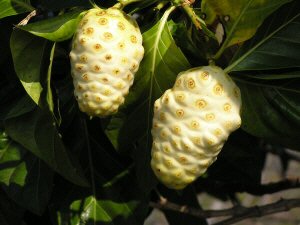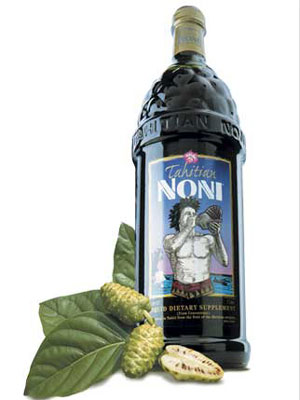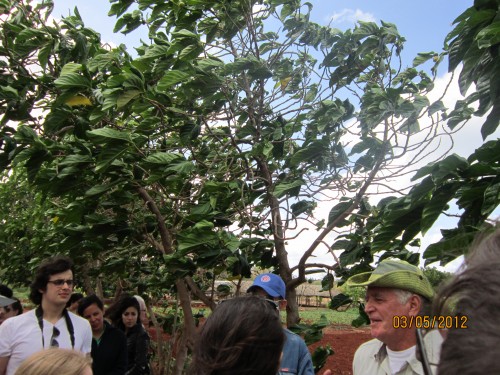The Miracle Fruit
May 2, 2012 by nialexandre
The Morinda citrifolia, commonly known as the noni in Cuba and Hawaii, the dog dumpling in Barbados, and the fromagier in France (a letter away from ‘fromager’, which is ‘cheese-maker’), is a very special kind of fruit. Cubans call it the miracle fruit, and it has a long history of uses as a traditional medicine. After having fell intro slight abandon in the early part of the 20th century, the special period’s return to natural means of medication popularized it amongst agriculturalists and biologists alike. Some of it’s modern uses are touted as curing everything from ADHD, to various cancers, rheumatism, and alzheimers. Pretty impressive, but it’s only in the past two decades or so that the noni’s many qualities have gained international recognition and began being used commercially in the developed world. However, it has received a fair amount of criticism for being sold as a remedy for just about anything, when in fact its juice, the only product that makes it to Western markets, functions mostly as an energy booster.
Native to Indonesia and Australia, the noni is, technically speaking, an invasive species in most countries. This is mostly due to its wide tolerance range rather than any kind of rapid growth exhibited by most invasives. It can flourish in a multitude of settings, including dry to mesic forests, disturbed forests, littoral forests, grasslands, pastures, open sea lines, and volcanic rock, provided they are situated at pan-tropical latitudes. It needs at minimum a temperature of about 12°C/54°F, but can weather extremely high temperatures provided it has sufficient water. In terms of it’s specific morphology, each tree sees a lot of variance in leaf size and structure, coloration, palatability, and seed number. A great sturdiness however is typical of noni seeds, and they are capable of spending months floating in water and still be viable due to a tight air pocket just bellow the outer shell, one of the reasons it can spread so easily. The tree has an extensive root system and a deep taproot, which makes it very resistant to fierce tropical winds. It is actually used in some cases to protect shorelines, a land-bound, and admittedly less capable of fostering biodiversity, version of mangroves. From the base of it’s trunk to the top of its crown, it ranges from 3 to 10 m in height and the fruit itself is usually about 3-4cm in diameter. In the wild, it can live from about 40 to 50 years. It is very susceptible to insect pests and parasitic weeds, with asphids and weevils amongst the main slayer of noni trees.
The fruits are generally thought to be the seat of the miracles, and they contain a variety of the chemical compounds such as amino acids (reputedly, 22 out of 24), anthraquinones, coumarins, fatty acids, flavonoids, iridoids, lignans, polysaccharides, sterols, sugars, sulfur-containing compounds, and terpenoids. These are indeed common elements the body requires for energy and stable health. This richness is what is generally described as the cause for the fruit’s fetid odor when ripe, harkening back to the Barbados and French names for it. However, as the quote from Scott Nelson’s article bellow illustrates, the entire plant can be put to use :
“Treatment for malaria, general febrifuge, and analgesic (leaf tea); laxative (all parts of the plant); jaundice (decoctions of stem bark); hypertension (extract of leaves, fruit, or bark); boils and carbuncles (fruit poultice); stomach ulcers (oils from the fruit); scalp insecticide (seed oil); tuberculosis, sprains, deep bruising, rheumatism (leaf or fruit poultices); sore throat (gargling a mash of the ripe fruit); body or intestinal worms (whole fresh fruits); fever (leaf poultice); cuts and wounds, abscesses, mouth and gum infections, toothaches (fruit); sties (flowers or vapor from broken leaves); stomach ache, fractures, diabetes, loss of appetite, urinary tract ailments, abdominal swelling, hernias, stings from stonefish, and human vitamin A deficiency (leaves).”
As mentioned above, many of these uses never leave the tropical areas and are practiced only by native populations who either can’t afford or chose not to use modern medicines. Of course, one might question their need to switch when such a plant is readily available. The noni is a reminder of the natural world’s bounty, and of humanity’s capability of putting it to use without compromising it. Part of the reason why all of the noni’s health benefits haven’t been capitalized on by northern countries is that many of the uses require the fruit to be fresh, which would be exceedingly difficult to supply to developed markets – and not merely because stores would have to come up with inventive ways of dealing with the smell. Another challenge is in the large scale processing of the plant. Many industrial methods, in an attempt to extract its benefits en mass, would damage the plant in ways that negate its medicinal capacities. Finally, there is now a cultural stigma around the noni due to the over enthusiastic marketing of its juice as a heal-all remedy, which makes it difficult to find the funds and the people interested in continuing research into the plant. So, for the time being, the Tropics keep their secrets and the noni continues its traditional use as a local, natural miracle.
Sources:
Ferment This: The Transformation of Noni, a Traditional Polynesian Medicine (Morinda citrifolia, Rubiaceae). Anna R. Dixon, Heather McMillen and Nina L. Etkin
Morinda citrifolia (noni). Scot C Nelson
Leave a Reply
You must be logged in to post a comment.


